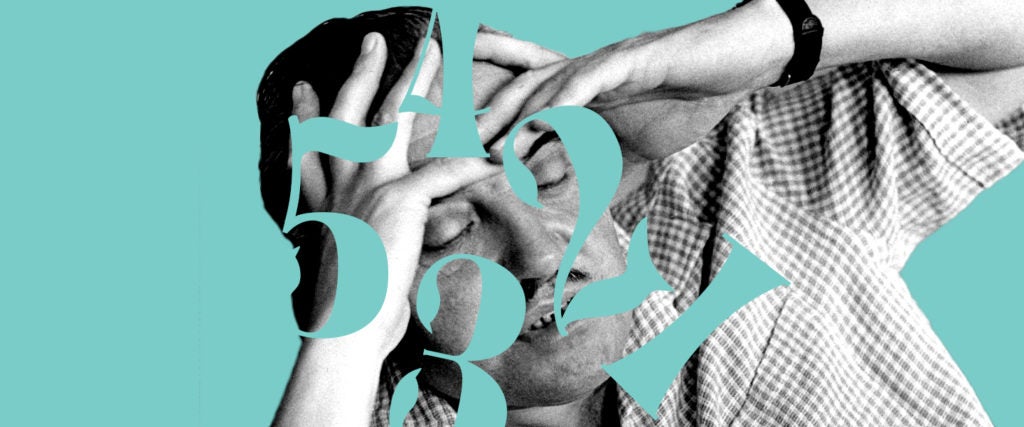About three minutes into the track “Gonna Raise Hell” on Kyle Kinane’s 2010 debut comedy album, the comedian runs through his morning routine. Eight a.m. [or 8:00] on a digital alarm clock just looks like the word ‘BOO,’” he jokes. Still, Kinane doesn’t let this scare him. Instead, he jumps out of bed naked, and cheerily greets both the day and all the items around his apartment. “Clean laundry, folded! Looking sharp. Nice work, guys. I like it. Dirty laundry, I see ya. You’re all right, I’ll get ya on the weekend.”
This bit came to mind recently when I learned about the grounding method for anxiety, which strangely starts out the same way. Also known as the 5-4-3-2-1 Coping Technique, the five-step process similarly leads off with identifying objects around the room. “Naming or categorizing things helps us to be focused on tuning in to our five senses and can serve as a distraction to reducing anxiety, depression and other symptoms,” counselor Tiffany Young tells me. That might sound simple enough, but it can be especially challenging while cooped up during the pandemic. “Quarantine can definitely make being grounded challenging and exacerbate anxiety because we’re literally sitting in what’s causing us distress and anxiety,” Young continues.
While there’s no definitive founder of the grounding method, it’s a mindfulness practice rooted in Buddhism that made its way into Western clinical psychology in the 1970s. Mindfulness, however, didn’t really start to become popular until the late 1980s when psychologist Marsha Linehan developed dialectical behavioral therapy, or DBT, a modified version of cognitive behavioral therapy. Mindfulness, or the ability to be in the present moment, is essential for DBT — an intense, evidence-based form of therapy originally designed for survivors of extreme childhood trauma — because it’s what keeps people from spiraling.
“Rumination can be very uncomfortable and anxiety-provoking, and it’s extremely common,” psychotherapist Rebekah Shackney says. “Grounding can move you out of your head, away from the negative tape that’s playing and bring you into the present.” As such, it also helps with decision-making more generally. “When you’re safe and grounded and back in a wise mind place, you can make the next right choice,” Shackney adds.
The best part about the grounding method, though, is its simplicity, which allows it to be utilized as a “daily, hourly and sometimes minute-by-minute practice, and not just as a one-time healing tool,” Young says.
Seriously, it’s as easy as counting backward from five.
Step #1: Name FIVE objects around you.
“Identifying and naming items gets you out of your head, away from the racing anxious thoughts, away from the replay of the trauma, and moves you into reality, where you’re safe,” Shackney explains.
Step #2: Think of FOUR things you can touch.
Next, you start to tap into your other senses by getting tactile. That said, it doesn’t have to be all touchy-feely or like you’re rolling on Molly. In my case, right now, I could touch my keyboard, my phone, my hair and my cup of coffee, which, admittedly, isn’t doing my anxiety any favors. But nevertheless, I can still touch it, so it counts.
Step #3: Identify THREE things you can hear.
Bring yourself further into the present by listening for three noises. Maybe it’s the birds outside, maybe it’s your stomach growling or even your own breath.
Step #4: Acknowledge TWO things you can smell.
From fresh-cut grass to hot garbage, summer is filled with smells to choose from. All you gotta do is open a window — or throw something in the microwave/stove. Speaking of which…
Step #5: Find ONE thing you can taste.
Did you know that gum has been found to curb anxiety? Part of the reason is that it taps into a person’s sense of taste, and brings them further into the present. But it doesn’t have to be gum. Whether it’s recognizing that your mouth tastes like this afternoon’s lunch or like metal from a recent panic attack, there’s no wrong answer here, and you only need to come up with one.
It’s worth noting that there are a number of other grounding techniques — e.g., deep breathing, exercising, listening to music and/or reciting positive affirmations. The key is finding what works for you, and integrating these practices in a consistent way. “There are so many reasons quarantine exacerbates anxiety,” Shackney says. “COVID, Black Lives Matter protests, the economy, homeschooling, no alone time, too much alone time, fear of losing jobs. People who are suffering are likely not very present. But if you really ground yourself in this moment, and let go of what you can’t control, you will reduce your suffering.”
After identifying items in his room, in “Gonna Raise Hell,” Kinane deviates from the 5-4-3-2-1 Coping Technique and moves into his bathroom for a “morning posedown” in a mirror with “champion” written on it in chapstick. While obviously not clinically approved, maybe that should become the sixth step?
Either way, I’m writing “winner” on my laptop in lipstick just in case.

